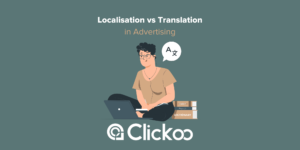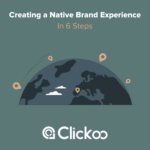It almost goes without saying, that success when advertising in any market is reliant on being able to effectively connect with your audience.
Language is an obvious barrier to achieving this when creating campaigns for international audiences.
This means at some point, you’ll probably go in search of translation services in your quest to grow overseas. However, language isn’t the only factor to consider, and solely focusing on translation for international content & campaigns can often generate underwhelming results.
To really speak to your international audiences, you should go deeper. That’s why localisation is growing in popularity as the more mature approach to international marketing – but how does it differ to translation, and why should you be localising your advertising, not just translating it?
We’re here we help you understand what distinguishes the two, along with their benefits and drawbacks, so you can determine which approach best suits your needs.
Translation
Translation – ‘ensuring words keep the same expression when changing them into another language’ – is essential if you want to target an audience in their mother tongue. Advances in technologies have improved its accessibility; machine translations like Google Translate are becoming ever more accurate.
One of the many factors search engines like Google consider when deciding where you sit on the search engine results page (aka, your organic ranking) is how many people leave your site immediately without interacting (or your bounce rate). As you can imagine, an untranslated website will send most visitors running for the hills, and whilst Google translate functionality is now built directly into some browsers – It’s still a major detractor from your potential customers experience (try it out for yourself) and search engines won’t reward you with the best page positions if your bounce rate is high.
With that in mind, ensuring that your owned media assets (website, social media pages etc) are translated into the local language is a fundamental step in entering a new market, but it definitely shouldn’t be the last step you take.
Translation in advertising is inherently limited as an approach, as it assumes that the only distinguishing factor between different countries is their language. But there are many other factors you need to bear in mind if you want to drive results (and ultimately growth) in markets around the world…
Localisation
Traditionally, language localisation takes things one step further than translation, and aims to connect with readers by considering more than just your audience’s language – that is, accommodating their linguistic quirks and cultural intricacies too to ensure your message really hits home.
Localising language is critically important when entering a new market. You’ll have no doubt heard of many big-name brands getting their translation wrong. The American Dairy Association’s famous slogan ‘Got milk?’ was advertised as ‘Are you lactating?’ to Spanish audiences, for example, resulting in considerable laughter, but also confusion. No one understood what they were trying to communicate at all.
As you can see, even though messages can be translated, things can still get lost in translation. So if you’re already advertising in multiple languages without localising your approach, it’s likely that you’re not achieving the maximum potential of your campaigns.
The next step, once you’ve localised your website and other owned media, is to build a localised advertising strategy. Localising your advertising approach goes beyond just the written element of your communication strategy. For example, a localised paid media strategy can take into account how your chosen market differs from others across hundreds of different macro & micro factors – These can be broadly segmented into two categories; the audience and the market.
Understanding how your audiences act is key. Do you know how they search for specific services? Or how they shop online? Or how exactly they speak? You’ll need to consider things like expressions and idioms, and which words are used differently. For instance, ‘gift’ means ‘poison’ in German, Danish, Norwegian and Swedish. A direct translation in this case would understandably struggle to see positive engagement!
By fully getting to grips with the market, you can also understand how businesses operate differently in different countries. Macro environmental factors can include things like; different peak seasons and public holidays, local legislation and a completely different set of competitors. For example, Australians celebrate Christmas in the sunshine (and very likely, without snow) and some countries have banned certain social media platforms.
Variances in the audience and market such as these can completely change the strategy required to succeed. By carefully considering these factors you can avoid investing in the wrong channels and critically, wasting your advertising budgets. In order to succeed in international advertising, you need to ensure you understand the intricacies of your chosen market, to allow you to build highly targeted advertising and an overarching marketing strategy that’s built for success.
Which should you choose?
If you want to truly communicate – and connect – with an audience, you need to go so much further than pure translation. Localisation may require a greater investment of time and resource, but done well, this investment will be far outweighed by the results and subsequent growth you’ll see. Even if machines can one day translate flawlessly, they will never be able to yield the full benefits of a localised market strategy.
This makes finding the right partners for your international advertising crucial to the success of your campaigns. With paid media experts for most major markets, localisation is at the heart of Clickoo. We work closely together with you to build your market strategy entirely around your audience, empowering your brand to connect with your customers across the globe on a human level.
You can truly go to new places by capitalising on our paid media knowledge. Get in touch to unleash the powers of Clickoo and localisation.
Want to learn more about advertising to international audiences?

Fill the form below to receive Clickoo’s guide to advertising in Europe.



